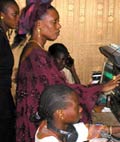
|
A Community Multimedia Centre (CMC) combines local radio by local people in local languages with a public telecentre facility offering access to internet, e-mail, computer training and a range of services and activities that meet development needs.
CMC Scale-up project CMC and Women's Microcredit Groups CMCs and Cultural Heritage Starting a CMC Go to CMC website
Since 2001, UNESCO has established over 40 pilot CMCs in three continents. These CMCs were created by adding new components to existing community facilities. In some cases, telecentres were added to community radio stations; in others, radio was added to existing telecentres.
The first full evaluation of UNESCO’s CMC programme takes place in 2005, but already empirical evidence points to notable achievements in the areas of rural access to ICT, communities’ capacity to use ICT and creation and accessibility of local content.
CMCs - Going to Scale in Mali, Mozambique and Senegal
Taking a pilot ICT4D project to scale is a huge challenge - moving from micro to macro, from individual centres to widely accessible facilities. UNESCO seeks through scale-up of CMCs to ensure that these communication and information platforms for development realize their full potential and make a difference to the lives of significant numbers of poor and marginalized communities.
The scale-up initiative was launched during the World Summit on the Information Society (WSIS) in Geneva in December 2003 by Mr. Koïchiro Matsuura, Director-General, UNESCO, Mr. Walter Fust, Director-General, Swiss Agency for Development and Cooperation (SDC), Mr. Toumani Toure, President of Mali, Mr. Joaquim Chissano, President of Mozambique, and Mr. Abdoulaye Wade, President of Senegal. More
Starting a CMC
Many community leaders and local activists are keen to develop CMCs. In order to help foster such initiatives, UNESCO supports capacity-building and has developed a number of innovative tools to meet the needs of CMC managers and staff. Starting a CMC is quite a challenge - it requires skills in a range of areas, from administration to Information Technology, from content production to social mobilization. Many partners of UNESCO contributed to its practical guide on CMCs “Getting Started and Keeping Going” (available in English and French). UNESCO and partner organizations are building a complete suite of workshop-ready, open-access training materials , the Multimedia Training Kit (MMTK), available online and on CD ROM. UNESCO has also produced a generic and yet easily customizable community browser, eNRICH.
The first full evaluation of UNESCO’s CMC programme takes place in 2005, but already empirical evidence points to notable achievements in the areas of rural access to ICT, communities’ capacity to use ICT and creation and accessibility of local content.
 | |
|
Taking a pilot ICT4D project to scale is a huge challenge - moving from micro to macro, from individual centres to widely accessible facilities. UNESCO seeks through scale-up of CMCs to ensure that these communication and information platforms for development realize their full potential and make a difference to the lives of significant numbers of poor and marginalized communities.
The scale-up initiative was launched during the World Summit on the Information Society (WSIS) in Geneva in December 2003 by Mr. Koïchiro Matsuura, Director-General, UNESCO, Mr. Walter Fust, Director-General, Swiss Agency for Development and Cooperation (SDC), Mr. Toumani Toure, President of Mali, Mr. Joaquim Chissano, President of Mozambique, and Mr. Abdoulaye Wade, President of Senegal. More
| CMC and Women's Microcredit Groups
Community Multimedia Centres offer microcredit groups an excellent platform for their activities. These groups, often run by and for women, operate cooperative loans and savings schemes that allow their members to fund essential purchases in order to run microentreprises. Microcredit activities require a lot of organisation, with many regular meetings, financial reports and accounts. The CMC's telecentre can help the women keep their accounts and run their book keeping. In Timbuktu, Mali, the community telecentre provided training and created forms and tables in the Songhay langauge for Subanafa, a women's microcredit group. In Senegal, a women's microcredit Afia is running a community radio supported by UNESCO, which plans to develop it into a CMC.  | CMCs and Cultural Heritage
CMCs can ensure that local communities benefit from cultural tourism and actively participate in the preservation of cultural and natural heritage. The Lumbini Community Multimedia Centre (CMC) in Nepal is located at the birthplace of Lord Buddha, a destination for pilgrims and visitors from all over the world. The centre seeks to promote sustainable tourism. It is developing a web portal for visitors and plans to train young people as tour guides. Recently, the CMC organized a photo competition for local people who took pictures of this World Heritage Site with the CMC's digital camera. Members of the community were first trained to use the camera, load the pictures onto computer and create and edit digital picture archives. This activity was run in parallel to a UNESCO competition on World Heritage for professional photographers. The local competition was part of the Lumbini CMC's efforts to popularize digital technologies. More in French  |
Starting a CMC
Many community leaders and local activists are keen to develop CMCs. In order to help foster such initiatives, UNESCO supports capacity-building and has developed a number of innovative tools to meet the needs of CMC managers and staff. Starting a CMC is quite a challenge - it requires skills in a range of areas, from administration to Information Technology, from content production to social mobilization. Many partners of UNESCO contributed to its practical guide on CMCs “Getting Started and Keeping Going” (available in English and French). UNESCO and partner organizations are building a complete suite of workshop-ready, open-access training materials , the Multimedia Training Kit (MMTK), available online and on CD ROM. UNESCO has also produced a generic and yet easily customizable community browser, eNRICH.
24-01-2005 (New Delhi)
18-01-2005 (Paris)
12-01-2005 (Paris)
11-01-2005 (Paris)
06-01-2005 (Paris)






